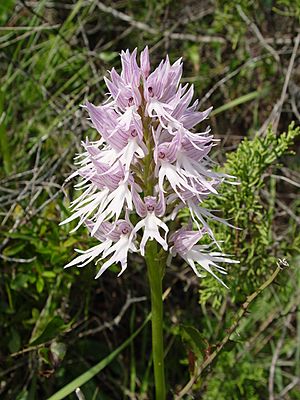Orchis facts for kids
Quick facts for kids Orchis |
|
|---|---|
 |
|
| Orchis italica | |
| Scientific classification |
|
| Kingdom: | Plantae |
| Clade: | Tracheophytes |
| Clade: | Angiosperms |
| Clade: | Monocots |
| Order: | Asparagales |
| Family: | Orchidaceae |
| Subfamily: | Orchidoideae |
| Subtribe: | Orchidinae |
| Genus: | Orchis Tourn. ex L. 1753 |
| Type species | |
| Orchis militaris L. Sp. Pl.: 943, 1753
|
|
| Species | |
|
See text |
|
| Synonyms | |
|
|
Orchis is a group of beautiful flowers that belong to the orchid family. You can find these plants mostly in Europe and Northwest Africa. They also grow as far away as Tibet, Mongolia, and Xinjiang.
Contents
What Are Orchis Plants Like?
These special orchids grow in the ground, not on trees like some other orchids. They have root tubers, which are like small, round storage organs, instead of pseudobulbs. This helps them store food and water.
Stems and Flowers
Orchis plants grow a straight stem that stands tall. At the top of the stem, they have a cluster of flowers called an inflorescence. This flower cluster looks like a cylinder or a ball. It can be about 5 to 15 centimeters (2 to 6 inches) long.
The flowers themselves can be yellow, red, or purple. Usually, the flowers at the bottom of the cluster open first, and then the ones higher up open slowly. But there's one type, the Monkey orchid (Orchis simia), that does the opposite! Its top flowers open first.
Where Orchis Plants Grow
Orchis plants are found in many different places. They can grow in forests, grasslands, and even near the seashore. They like areas with a mild climate.
How Scientists Group Orchids
Long ago, the group Orchis included more than 1,300 different plant names. But scientists realized that this group was too big and contained plants that weren't closely related. This is called being "polyphyletic."
To make things clearer, scientists like Pridgeon and his team divided the original Orchis group into several smaller, more accurate groups. These new groups include Ponerorchis, Schizodium, and Steveniella. This helps us understand the relationships between different orchid species better.
See also
 In Spanish: Orchis para niños
In Spanish: Orchis para niños

